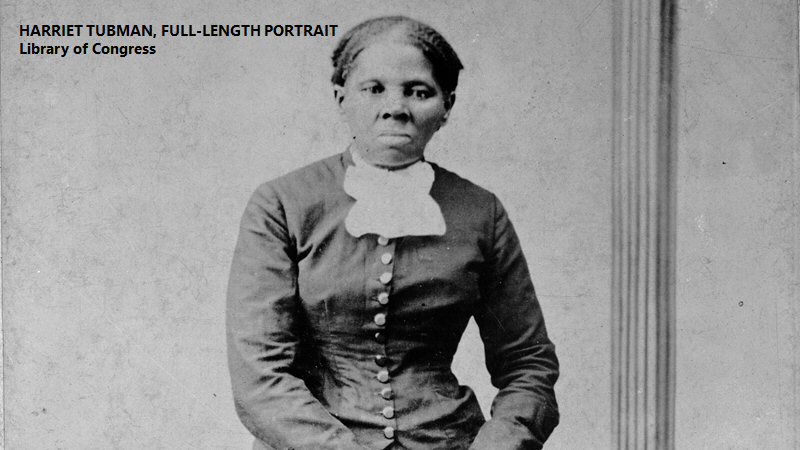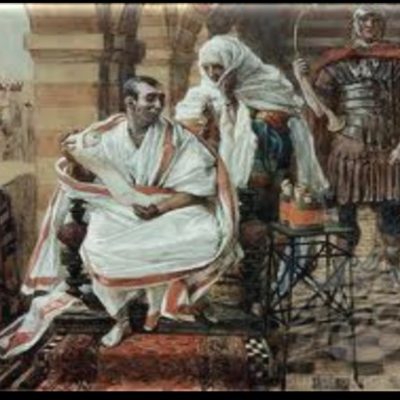Harriet Tubman Unsung Hero from the Civil War:

Harriet Tubman was an unsung hero from the Civil War. She was a woman who successfully aided many slaves to escape before and during the Civil War. Harriet Tubman was a “conductor” of the Underground Railroad. There is many things that can be said about the character of Harriet Tubman that holds her in high esteem. I respect her dedication to her cause and her commitment to what she believed. The life of Harriet Tubman is a life of courage and determination. Born a slave, married a freed black slave, and fled to Canada in order to remain free. She was a God fearing woman who devoted her life to fight against slavery, and a champion of women rights. She was an incredibly brave woman who was known as the “Moses of her people.” Harriet Tubman never lost a passenger. Harriet Tubman was a deeply religious woman who never doubted that her actions were guided by God through omens and dreams.
The fugitive slaves were men and women of all ages who left the plantation and headed north for freedom. Most runaway slaves were young men who could withstand the hardships of the fugitive life. The escape route from the Deep South to the North to New York, Massachusetts or Canada meant a journey of hundreds of miles which was usually on foot. Escaped fugitive slaves faced a life of hardship, with little food, scarce access to shelter or medical care, and the constant threat of local sheriffs, slave catchers or civilian lynch mobs. (American Experience PBS).
We should have a very high regard for an incredibly brave woman who could not read or write, yet led many out of slavery and into freedom. She helped set up schools for freed slaves. Harriet Tubman stated: “I always told God: I’m gwine to hole stiddy on to you, and you got to see me trou … Jes so long as He wants to use me, He’ll tak ker of me, and when He don’t want me any longer, I’m ready to go.” (Federer. 2001). To her biographer, Sarah H. Bradford, Harriet Tubman related in 1868: ’Twant me, ’twas the Lord. I always told him, “I trust to you. I don’t know where to go or what to do, but I expect you to lead me,” and he always did. (Federer. 2001).
She had foreseen the Civil War in a vision years earlier. Harriet served as a nurse, a cook, a northern spy, and scout for the Union Army during the Civil War. She had secured military information from blacks behind the Confederate lines. She risked her life over and over again in the name of freedom for all. (Christian History Magazine. 1992).
It was round 1844 Harriet married a free black named John Tubman and took his last name. (She was born Araminta Ross; she later changed her first name to Harriet, after her mother.) It was in 1849, in fear that she, along with the other slaves on the plantation, was to be sold, she was determined to run away. She set out one night on foot. With some assistance from a friendly white woman, Tubman was on her way. She followed the North Star by night, making her way to Pennsylvania and soon after to Philadelphia, where she found work and saved her money. The following year she returned to Maryland and escorted her sister and her sister’s two children to freedom. She made the dangerous trip back to the South soon after to rescue her brother and two other men. It was on her third return, she went after her husband, only to find he had taken another wife. Undeterred, she found other slaves seeking freedom and escorted them to the North. (PBS. Harriet Tubman). When she first reached the North, she said r, “I looked at my hands to see if I was de same person now I was free. Dere was such a glory ober eberything, de sun came like gold through de trees and ober de fields, and I felt like I was heaven.” (Savage. 2000).
Tubman said she would listen carefully to the voice of God as she led slaves north, and she would only go where she felt God was leading her. Fellow abolitionist Thomas Garrett said of her, “I never met any person of any color who had more confidence in the voice of God.” (Savage. 2000).
Harriet Tubman returned to the South again and again. She devised clever plans that helped make her raids successful, including using the master’s horse and buggy for the first leg of the journey; leaving on a Saturday night, since runaway notices couldn’t be placed in newspapers until Monday morning; turning about and heading south if she encountered possible slave hunters; and carrying a drug to use on a baby if its crying might put the fugitives in danger. Harriet Tubman even carried a gun which she used to threaten the fugitives if they became too tired or decided to turn back, telling them, “You’ll be free or die.” (PBS. Harriet Tubman).
Though furious slaveholders posted a $40,000 reward for her capture, in 1856, she was never apprehended. “I can’t die but once” became her motto, and with that philosophy she went about her work of deliverance. (Christian History Magazine. 1999). On one occasion, in 1856, she overheard some men reading her wanted poster, which stated that she was illiterate. She promptly pulled out a book and pretended reading it. The ploy was enough to fool the men. (PBS. Harriet Tubman).
Tubman had made the perilous trip to slave country 19 times by 1860, including one especially challenging journey in which she rescued her 70-year-old parents. Of the famed heroine, who became known as “Moses,” Frederick Douglass said, “Excepting John Brown — of sacred memory — I know of no one who has willingly encountered more perils and hardships to serve our enslaved people than Tubman, sometimes called “the Moses of her people,” was a deeply religious woman who never doubted that her actions were guided by God through omens and dreams. (PBS. Harriet Tubman). During the Civil War, Tubman served as a nurse, laundress, cook, scout and spy with Union forces along the coast of South Carolina. She made her home in Auburn, New York, and, despite numerous honors, spent her last years in poverty after the war. It was not until 30 years after the war when Harriet Tubman was granted a government pension in recognition of her work for the Federal Army. (Galli. 2000. pgs 295–296 ).
There were no tracks on the Underground Railroad, or even any designated routes. Neither did anyone hide or travel underground. The Underground Railroad was simply a loose network of free blacks and whites in the North who helped an estimated 40,000 to 100,000 fugitive slaves find freedom in the northern United States and Canada. There were individuals that helped with the Underground Railroad and offered the fugitive slaves a place to hide of a day or two. There were others who provided money for their travel to Canada, there were a few who went south to personally help lead slaves to freedom. (Christian History Magazine. 1999).
The undertaking of helping fugitive slaves was not an easy one. Those known to be involved in the Underground Railroad were threatened, criticized publically in popular books and newspapers in both the North and South. Neighbors spied on their activities, and slave owners and slave catchers kept their houses and businesses under almost constant watch. Some were asked to leave their churches, and their children were often harassed and bullied in school. Others, fearing for their lives, left their homes and moved to other states. (Christian History Magazine. 1999).
There was no amount of threat that would deter these people from the runaway slaves. They were driven by their Christian faith believing that “all men are created equal.” Those who were driven to help were called “Conductors” on the Underground Railroad. When a fugitive slave came into their area, these “conductors” on the Underground Railroad acted quickly to usher him inside and into a safe hiding place. The fugitive slave where helped by offers of a meal, money even a disguise. They were sent on the next leg of their journey north and to freedom. Many slaves found a new home among the large free black communities of Philadelphia, Buffalo, Detroit, and Cincinnati; others found homes in Canada. Some slaves began new lives as domestic servants, mechanics, and field laborers, but many did not have any marketable skills and found life in the North very difficult. (Christian History Magazine. 1999). Free black communities, especially the churches, were active in this work. Depending on the situation, the slave was offered a meal, money, a disguise, and help in finding the next safe haven as he journeyed north. (Christian History Magazine. 1999).
She always made her rescue attempts in winter but avoided actually going into plantations. Instead she waited for escaping slaves (to whom she had sent messages) to meet her eight or ten miles away. Slaves would leave plantations on Saturday nights so that they wouldn’t be missed until Monday morning, after the Sabbath. It would thus often be late on Monday afternoon before their owners would discover their slaves were missing. Only then did they post their reward signs; signs men hired by Tubman would take down. (Christian History Magazine. 1999). She died in 1913. (PBS.)
Just like the fugitive slaves were looking for freedom from bondage; we are all looking for freedom from our bondage from sin. The fugitive slaves had to take into consideration the cost of their escape. They had to consider how they would get from point A to point B. Every step we take to escape from the bondage of sin we ask ourselves what is the cost. Our cost was paid by Jesus Christ on the cross.
“For ye have not received the spirit of bondage again to fear; but ye have received the Spirit of adoption, whereby we cry, Abba, Father.” (Romans 8:15). It is in Christ Jesus we have been given the liberty and been made free from bondage. (Galatians 5:1).
References:
American Experience PBS. “The Time of the Lincolns.” American Experience PBS. Retrieved Oct 28, 2015 from: <http://www.pbs.org/wgbh/amex/lincolns/slavery/es_underground.html.>
Christian History Magazine. (1992). “Other Key Figures,” Christian History Magazine-Issue 33: Christianity & the Civil War. Carol Stream, IL: Christianity Today.
Christian History Magazine. (1999). “Black Moses,” Christian History Magazine-Issue 62: Bound for Canaan: Africans in America (Carol Stream, IL: Christianity Today.
Federer, William J. (2001) Great Quotations: A Collection of Passages, Phrases, and Quotations Influencing Early and Modern World History Referenced according to Their Sources in Literature, Memoirs, Letters, Governmental Documents, Speeches, Charters, Court Decisions and Constitutions . St. Louis, MO: AmeriSearch.
Galli, Mark and Olsen, Ted. (2000) “Introduction,” 131 Christians Everyone Should Know. Nashville, TN: Broadman & Holman Publishers.
PBS. Harriet Tubman. “People & Events Harriet Tubman.” PBS. Retrieved on Oct 28 2015 <http://www.pbs.org/wgbh/aia/part4/4p1535.html.>
Savage, Douglas J. (2000). Untold History of the civil War Women in the Civil War. Philadelphia: Chelsea House Publishers.
Underground Railroad. “The Underground Railroad” National Geographic Society. Retrieved Oct 28, 2015 from: http://www.nationalgeographic.com.
Cite Article Source
MLA Style Citation:
Holstein, Joanne “Harriet Tubman Unsung Hero from the Civil War:.” Becker Bible Studies Library Nov 2015.<https://guidedbiblestudies.com/?p=2943,>.
APA Style Citation:
Holstein, Joanne (2015, November) “Harriet Tubman Unsung Hero from the Civil War:.” Becker Bible Studies Library. Retrieved from https://guidedbiblestudies.com/?p=2943,.
Chicago Style Citation:
Holstein, Joanne (2015) “Harriet Tubman Unsung Hero from the Civil War:.” Becker Bible Studies Library (November), https://guidedbiblestudies.com/?p=2943, (accessed).
